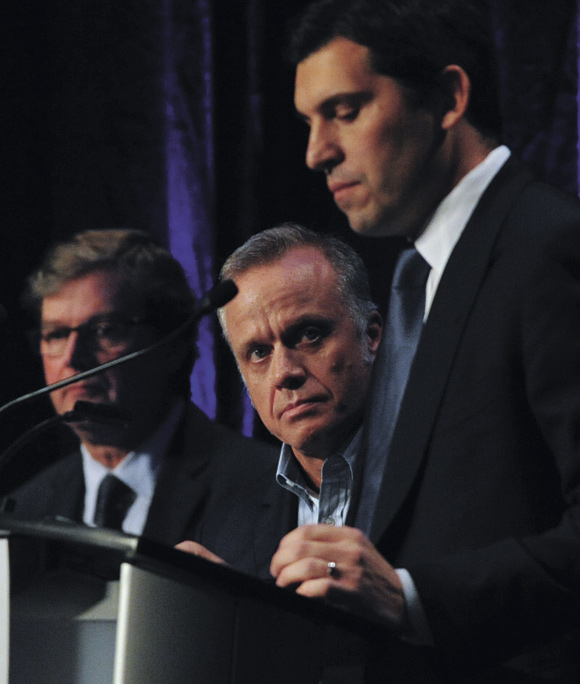Reading The Signs
STEVEN THRENDYLE
Other


FROM LEFT: TONY ASTLES, EXECUTIVE VICE-PRESIDENT OF BENTALL KENNEDY, ERIC CARLSON, OF ANTHEM PROPERTIES, and COLIN BOSA, CEO OF BOSA PROPERTIES TOOK PART IN A PANEL DISCUSSION DURING URBAN DEVELOPMENT INSTITUTE’S ANNUAL MARKET FORECAST.
In mid-January of each year, more than 1,000 real estate professionals, from developers to sales managers to politicians of all stripes, gather in Vancouver for the first meeting of the Urban Development Institute (Pacific Region).
And the topic is always the same: “What’s the annual forecast for the residential and commercial real estate market?”
For 2013, Diana McMeekin, president of Artemis Marketing, moderated a panel discussion between Tony Astles, executive vice-president of Bentall Kennedy, Eric Carlson, president and CEO of Anthem Properties, and Colin Bosa, CEO of Bosa Properties.
2012 was a year in which there were a lot of contradictory trends. The number of home sales – especially re-sales in high priced neighbourhoods such as the West Side and West Vancouver – seemed to tumble each month, news that was transmitted via doom-peddling blogs and, as one participant at the meeting said, “the Toronto media.”
Prices themselves, however, remained fairly steady. As Colin Bosa said, “Clearly, making an average of 11 per cent per year from 2003 to 2011 is not sustainable.” However, confidence in the future amongst developers seems strong, new housing starts expanded to just over 19,000 from 17,000 – one of the most active years in the past two decades.
Commercial real estate specialist Tony Astles cautioned against “the bad blitz of world economic news that has badly battered investor confidence while governments continue to kick their problems down the road.”
His forecast for 2013 was that “the Vancouver market has continued to make progress during strange times. We have some of the best risk-adjusted properties in the world. Real estate around the Lower Mainland represents a very local economy.” Much of the current demand in the Lower Mainland is near transit lines outside of the city limits. In fact, to Astles, one of the major challenges is a labour force in which experienced workers are retiring and being replaced by younger workers. Overall, however, Astles is bullish on the market.
For Eric Carlson, of Anthem properties, “The years from 2009 to 2012 were very good for B.C., but not so good for the world – with Middle East and African turmoil and the European debt crisis and the 24-hour news cycle reporting on it every minute of the day.”
B.C., which relies on in-migration from other parts of Canada as well as investment from China and the United States, has been “pretty smug about the situation up here.” He said multi-family rentals will continue to be a low-risk investment, particularly because of limited supply.
“I think in 2013 you’ll see a lot of the fear go away. The United States’ recovery will absorb all of the homes left over from the sub-prime crisis and builders will start bringing on new product. That will help the B.C. economy due to demand for forest products since there are three jobs created down there for every home that is built. The demand for B.C. lumber will go up, which will create more high paying jobs up here.”
Speaking specifically about the residential condo market, Colin Bosa, of Bosa Properties, still sees a lot of life left in B.C.’s long term housing markets, even though he’s prepared to admit that there has been overbuilding in certain neighbourhoods, such as Southeast False Creek (near the Olympic Village) and in Coquitlam centre, which is still a few years away from being connected to Vancouver by the Evergreen transit line. “The mainland Chinese are still very interested in property around Metrotown, where currently there is no inventory for sale.”
“If interest rates remain low, net migration returns to the 40,000 mark, and housing starts continue at around the long-term average of 15,000 per year, then the market will be balanced.” Developers will have to concentrate on efficient floor plans, locations close to transit, and bring well priced products to market.
“The good news for all the salespeople in the room is, you’re going to sell lots of real estate this year, but the bad news is you’re going to have to work at it.”
The take-away message is that the housing bubble Vancouver might have experienced a couple of years ago will not pop in 2013, although interest rates cannot increase and immigration from foreign countries – notably from China – will have to stay strong. Annually, British Columbia draws up to 50,000 newcomers internationally and from other parts of Canada and while these three speakers foresee long term prosperity, the average Lower Mainland homeowner can’t expect to see the huge jumps that occurred between 2009 and 2011 happening any time soon.
